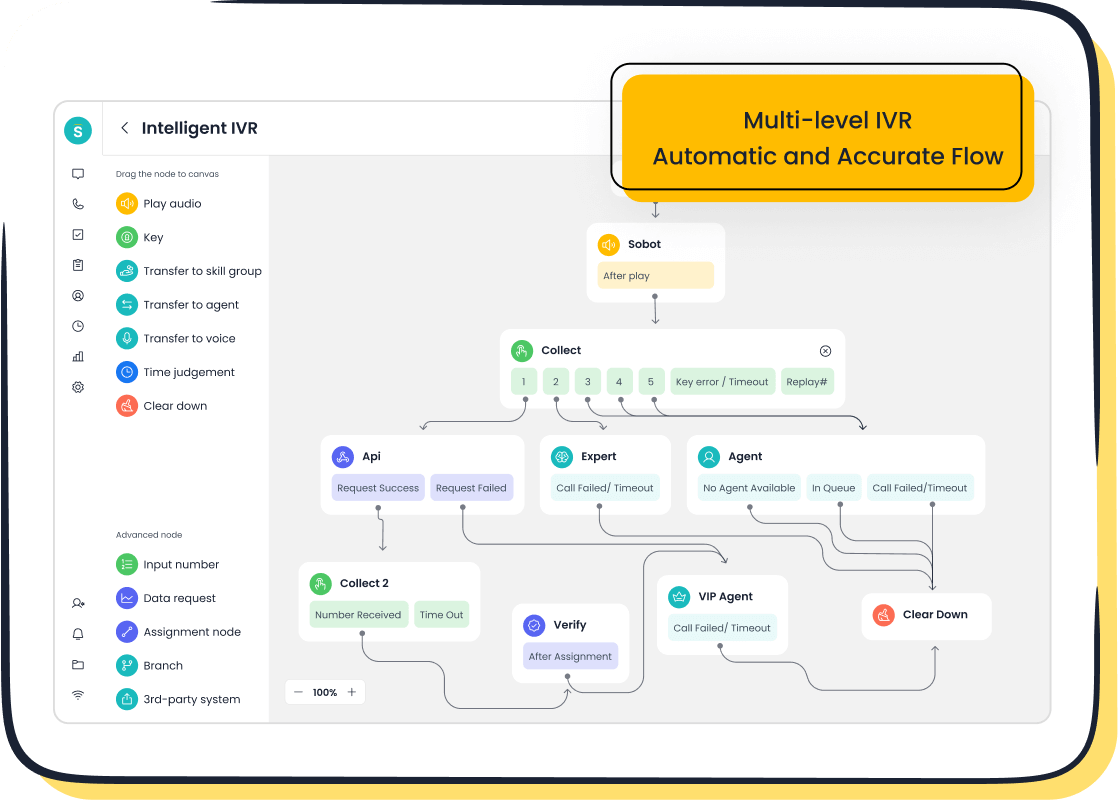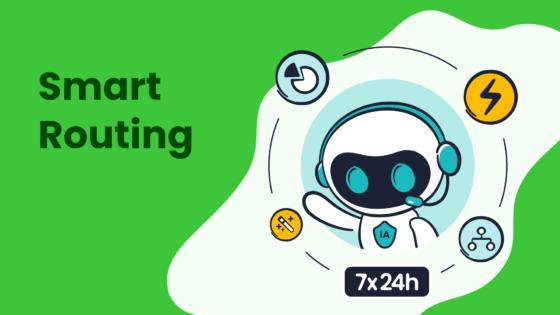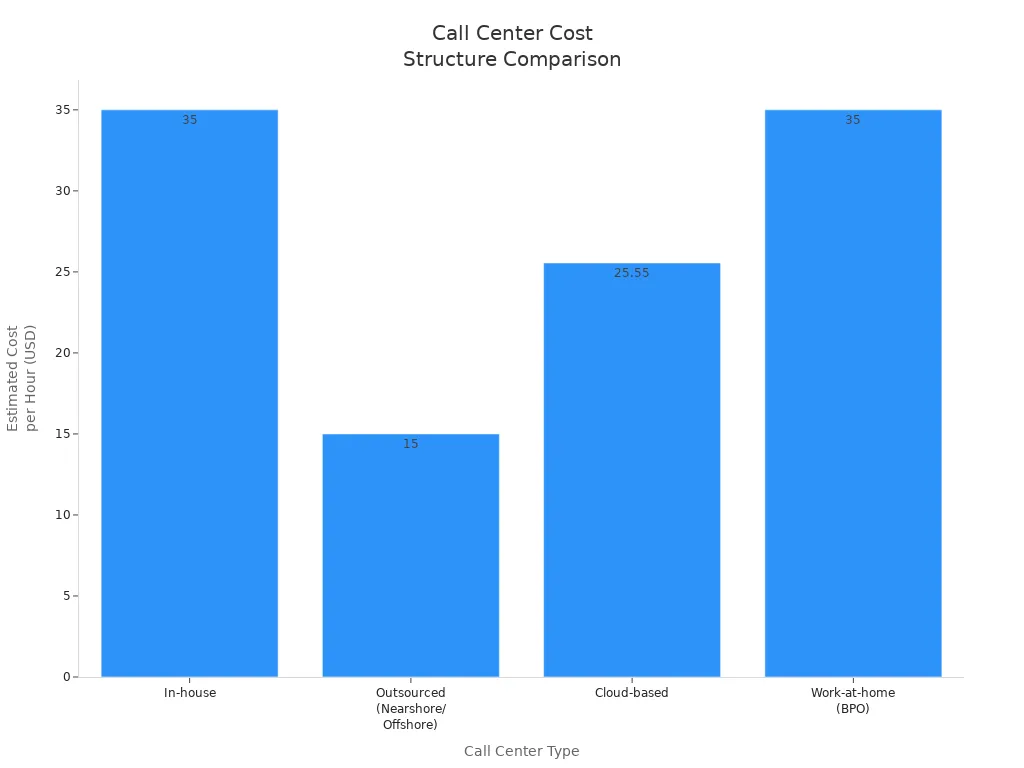Efficient Call Center Structure Comparison Guide

The most efficient call center structure depends on business needs, company size, and service goals. Recent studies show that structures with strong employee engagement and integrated quality assurance improve customer satisfaction. Companies often choose a contact center model that aligns with efficiency metrics, such as cost, scalability, and technology. Sobot delivers innovative contact center solutions, like Sobot AI and Sobot call center, to help businesses boost customer service and operational results.
Call Center Structures

In-House Call Center
An in-house call center operates within a company’s own facilities. The business hires and manages all service agents directly. This model gives full control over training, quality, and brand voice. In-house call centers often use centralized management and integrate with internal systems like CRM or HR software. They require significant investment in staff, technology, and infrastructure. For example, a team of four customer service representatives and one manager can cost over $180,000 per year, including salaries and benefits. Companies choose this model for better communication, faster problem-solving, and improved customer experience.
Outsourced Call Center
Outsourced call centers are managed by third-party providers. Businesses use this model to save costs, scale quickly, and access specialized expertise. Outsourced call centers offer flexibility to handle peak periods and provide support in multiple languages and time zones. However, companies may face challenges with quality control and data security. Clear communication and technology integration help maximize benefits. Many enterprises use outsourced call centers to focus on core activities while ensuring efficient customer service.
Cloud-Based Contact Centers

Cloud-based contact centers use internet-based platforms to manage customer interactions. Providers like Sobot offer contact center as a service, allowing fast deployment and easy scaling. Companies avoid large upfront costs and pay a subscription fee instead. Cloud-based contact centers support remote work, global reach, and high uptime. Sobot’s Voice/Call Center delivers 99.99% system stability, AI-powered features, and seamless integration with existing systems. This model enables businesses to add or remove agent seats as needed, making it an efficient call center solution.
Virtual Call Center
A virtual call center connects agents working from different locations through cloud technology. Real-time data synchronization and AI-powered tools help agents collaborate and deliver consistent service. Automated workflows and sentiment analysis improve efficiency. Virtual call centers support multilingual teams and flexible schedules. This model suits companies seeking cost savings and access to a wider talent pool.
Omnichannel Contact Center
An omnichannel contact center integrates multiple contact options—such as phone, email, chat, and social media—into one platform. Agents can view all customer interactions in a unified workspace, preserving context and history. Sobot’s Omnichannel Solution provides advanced omnichannel support, AI chatbots, and automation. Customers can switch channels without repeating information, and agents deliver personalized service. Omnichannel capabilities improve customer satisfaction and loyalty by offering seamless, consistent experiences.
Companies often select specialized call center models, such as multilingual or ai-assisted call centers, to meet unique business needs. These models use advanced technology and multiple contact options to serve customers efficiently.
Efficiency Metrics

Cost
Cost efficiency remains a top priority for every call center and contact center. In-house call centers often have the highest costs. These include salaries, management, technology, and facilities. Outsourced call centers lower costs by using operational expenses instead of capital expenses. Cloud-based contact centers, like Sobot’s Voice/Call Center, reduce costs by removing the need for expensive hardware and offering pay-as-you-go pricing. Automation and AI-assisted call centers can cut staffing needs by up to 40%. Work-from-home models also save on facility costs. The chart below shows how costs compare across different models:

Accurate cost comparisons should include all expenses, not just agent wages. Cloud-based solutions like Sobot’s contact center as a service help businesses achieve better cost efficiency.
Scalability
Scalability means how easily a call center can grow or shrink. Traditional call centers need new hardware and more space to add agents, which takes time and money. Cloud-based and virtual contact centers scale quickly by adding users through software. Sobot’s global network and 99.99% uptime make scaling simple and reliable. AI-assisted call centers also support flexible staffing, letting companies handle busy times without extra costs. Cloud solutions help businesses reduce hardware costs by over 50% and support remote work, making them ideal for fast growth.
Technology
Technology drives quality and efficiency in modern contact centers. AI and automation handle routine tasks, freeing agents to focus on complex issues. Sobot’s AI-powered features, such as chatbots and intelligent IVR, improve agent performance and customer interaction. Integration with CRM systems gives agents instant access to customer data, supporting personalization and better service. Omnichannel support unifies all channels, so agents deliver frictionless support. Cloud technology ensures high reliability and easy updates. AI-powered analytics and sentiment analysis help managers track quality and improve agent training.
Customer Experience
Customer experience shapes satisfaction and loyalty. Omnichannel contact centers, like Sobot’s solution, let customers switch channels without repeating information. This seamless approach boosts customer satisfaction and supports a strong customer experience strategy. Studies show omnichannel support raises customer satisfaction scores to 67%, much higher than multi-channel centers. AI-assisted call centers use personalization and automation to deliver fast, accurate answers. Quality scores, Net Promoter Score (NPS), and first call resolution rates help measure success. Sobot’s tools help businesses create personalized experiences and improve overall satisfaction.
Key efficiency metrics include average speed of answer, cost per call, agent utilization, call quality, and customer churn. Sobot’s advanced AI and global reach set a high standard for quality and customer experience strategy in the industry.
Efficient Call Center Comparison
Side-by-Side Table
Choosing the right call center structure can make a big difference in cost, scalability, technology, and customer experience. The table below compares the main types of call centers and contact centers across these important factors:
| Call Center Structure | Cost Considerations | Scalability | Technology | Customer Experience |
|---|---|---|---|---|
| In-House | Higher operational costs; investment in staff, training, and infrastructure | Limited; scaling up requires more space and hiring | Basic to advanced, depending on investment | Consistent brand voice; may lack speed and flexibility |
| Outsourced (Domestic) | 25-35% higher than offshore; pays for local wages and compliance | Moderate; easier to add agents, but less flexible | Strong local integration; good compliance | High satisfaction from cultural alignment |
| Outsourced (Offshore) | 40-60% cost savings compared to domestic | Good; large labor pool, but time zone challenges | Varies; may lack advanced integration | May face communication and cultural barriers |
| Cloud-Based Contact Center | Lower upfront costs; pay-as-you-go pricing | Highly scalable; add or remove agents easily | Omnichannel, AI, CRM integration, analytics | Seamless transitions; high engagement |
| Virtual Call Center | Saves on facilities; flexible staffing | Highly scalable; supports remote work | Cloud-based tools, real-time data, AI | Consistent service; flexible support |
| Omnichannel Contact Center | Subscription pricing; reduces infrastructure costs | Highly scalable; supports multiple channels | Unified workspace, AI chatbots, analytics | Seamless, personalized, and efficient experiences |
| AI-Enhanced | Reduces per-interaction costs by 60-70% | Handles large volumes without quality loss | Advanced AI, real-time transcription, sentiment analysis | Fast, accurate, and high-quality service |
Note: Cloud-based and omnichannel solutions, such as those from Sobot, offer high system stability (99.99% uptime), global reach, and advanced AI features. These features help businesses achieve an efficient call center setup that adapts to changing needs.
Key Takeaways
A side-by-side comparison shows that cloud-based and omnichannel contact centers provide the most flexibility and efficiency. These models use advanced technology, such as AI chatbots and unified workspaces, to improve both agent performance and customer experience. Companies that use AI-enhanced solutions can reduce operational costs by up to 70% and handle more customer requests without losing quality.
Sobot’s Voice/Call Center and Omnichannel Solution stand out in this area. Sobot’s platform supports global operations, offers 99.99% uptime, and integrates AI-powered features like intelligent IVR and chatbots. These tools help businesses deliver fast, accurate, and high-quality service across all channels.
Real-world results show the impact of an efficient call center structure. For example, Agilent, a leader in life sciences, partnered with Sobot to upgrade its customer service. By using Sobot’s omnichannel workbench and AI chatbot, Agilent increased its customer service efficiency by six times and reduced costs by 25%. The company also achieved a customer satisfaction score of 95%. This success came from combining automation, intelligent routing, and unified data management. Read more about Agilent’s story.
Many global brands have seen similar gains after switching to modern contact center solutions. For instance, companies like American Airlines and Google have reported up to 50% reductions in handling times and major improvements in agent retention and satisfaction after adopting AI and cloud-based platforms.
Tip: When planning a new call center or contact center, leaders should set clear goals, invest in the right technology, and focus on agent training. Avoid common pitfalls like unclear expectations, outdated systems, and lack of automation. AI and cloud-based solutions help address these issues by automating routine tasks, improving call routing, and providing real-time analytics.
Choosing the Right Contact Center
Decision Criteria
Selecting the best call center or contact center structure depends on several important factors. Companies should consider control, cost, scalability, privacy, language needs, and technology. The table below shows how in-house and outsourced call centers compare on these factors:
| Factor | In-House Call Centers | Outsourced Call Centers |
|---|---|---|
| Control | Direct supervision, strong brand alignment | Less direct control, needs agent training |
| Cost | Higher for space, training, and operations | More cost-effective, agents already trained |
| Scalability | Slower to scale, needs more resources | Flexible and quick to scale |
| Privacy | Best for high privacy needs | Less suitable for sensitive data |
| Language & Culture | Local language and culture | Multilingual, global time zone coverage |
| Tech Adaptability | May lag in tech updates | Adopts new tech faster |
| Best For | Small, private, stable businesses | Global, high-volume, or fast-changing needs |
Companies that want direct control and privacy may choose in-house models. Businesses needing fast growth, multilingual support, or cost savings often select outsourced or cloud-based call centers. Sobot’s contact center as a service offers flexibility, advanced technology, and global reach, making it a strong choice for many organizations.
Industry Use Cases
Different industries use call center models based on their unique needs. For example:
- SaaS companies often outsource Tier-1 customer support to scale quickly and improve response times.
- E-commerce retailers use nearshore outsourcing for 24/7 coverage, which helps boost customer experience and repeat purchases.
- Global businesses rely on cloud-based contact centers for multilingual support and rapid adaptation.
- Healthcare and banking prefer in-house or onshore centers for privacy and compliance.
| Call Center Type | Description & Benefits | Typical Industry Use Cases |
|---|---|---|
| Inbound Call Center | Handles incoming calls, supports many needs | Real estate, healthcare, insurance, banking, IT |
| Outbound Call Center | Makes outgoing calls for sales or surveys | Financial services, retail, telemarketing |
| Onshore Call Center | Local language and culture fit | High-tech products, local support |
| Nearshore Call Center | Cost-effective, similar culture, time zone alignment | Bilingual support, 24/7 service |
| Offshore Call Center | Lower costs, 24/7 global support | Global companies, high call volumes |
Sobot’s omnichannel contact center solution helps companies in retail, finance, and life sciences deliver seamless customer service. For example, Agilent improved efficiency and customer satisfaction by using Sobot’s AI-powered platform.
Transition Steps
Moving from a traditional call center to a cloud-based or virtual model involves several steps:
- Define the purpose and type of call center based on business goals.
- Select key metrics like first call resolution and customer satisfaction.
- Approve the budget and choose the right technology partner.
- Integrate systems such as VoIP and CRM for smooth operations.
- Hire and train agents with the needed skills and tools.
- Test hardware and internet for remote agents.
- Document call scripts and escalation paths.
- Automate workflows, including call routing and reporting.
- Launch a pilot phase to gather feedback and make improvements.
- Update all contact information to reflect the new center.
Sobot supports businesses through each step, offering secure integration, AI-powered automation, and a unified workspace. These features help companies build a strong customer experience strategy and deliver personalized support across all channels.
Tip: Companies should provide ongoing training and promote team cohesion during the transition. This approach ensures agents deliver high-quality customer support and maintain a strong customer experience strategy.
Trends in Customer Service
AI and Automation
AI is changing how companies deliver customer service. Many businesses now use AI to automate routine tasks, such as answering common questions or routing calls. This technology helps reduce response times and increases efficiency. AI-powered chatbots and virtual assistants can provide 24/7 support, allowing customers to get help at any time. These tools also analyze customer behavior and preferences, making each interaction more personal. For example, predictive analytics can identify customers who might leave and help companies act before problems grow. AI-assisted call centers use these features to improve both speed and accuracy. Sobot’s platform uses AI to power intelligent IVR, chatbots, and real-time analytics, helping agents focus on complex issues and deliver better service.
Remote and Hybrid Models
Remote and hybrid call center models have become popular. These models let employees work from home or split time between home and the office. Companies benefit from lower costs, access to a wider talent pool, and increased flexibility. Agents often feel happier and more productive because they avoid long commutes and can manage their schedules. However, remote work can create challenges, such as communication gaps and technology issues. Successful companies use digital tools, clear policies, and regular check-ins to keep teams connected. Sobot’s cloud-based solutions support remote and hybrid teams by providing secure, reliable access to all contact center features from anywhere.
Evolving Expectations
Customer expectations have changed a lot in recent years. People want fast, real-time support across many channels, including phone, email, chat, and social media. Omnichannel support has become essential, as customers expect to switch channels without repeating information. Self-service options, like AI-powered chatbots and online knowledge bases, are now standard. Customers also care about data privacy and want companies to protect their information. Sobot’s omnichannel solution helps businesses meet these demands by unifying all customer interactions and providing secure, personalized service. Companies that invest in training, technology, and personalized communication build stronger relationships and improve satisfaction.
No single call center structure works best for every business. Each model has clear strengths:
- Small businesses often choose simple call center setups for cost and ease.
- Companies with many customer channels benefit from scalable, omnichannel contact centers.
- Organizations focused on fast call flow prefer traditional call centers.
- Contact centers help brands deliver personalized service across platforms.
Most businesses should start by assessing their needs and goals. They can measure key metrics like First Call Resolution and Net Promoter Score, then consult with solution providers such as Sobot. Piloting new models helps find the right fit. Sobot stands out with advanced AI, omnichannel support, and secure global solutions—making it a smart choice for efficient, scalable contact center operations.
FAQ
What is the most efficient call center structure for a growing business?
The most efficient call center structure for a growing business is often a cloud-based or omnichannel contact center. These models scale quickly, support remote teams, and use advanced technology. Sobot’s solutions help businesses improve customer experience and reduce costs as they grow.
How does an omnichannel contact center improve customer experience?
An omnichannel contact center lets customers switch between channels like phone, chat, and email without repeating information. Agents see all interactions in one place. Sobot’s Omnichannel Solution helps companies deliver seamless, efficient call center service and boost customer satisfaction.
What are the main benefits of using AI in a call center structure?
AI in a call center structure automates routine tasks, speeds up response times, and provides 24/7 support. Sobot’s AI-powered chatbots and intelligent IVR help agents focus on complex issues, leading to a more efficient call center and better customer experience.
How can a company measure the efficiency of its call center structure?
Companies measure efficiency using metrics like average speed of answer, first call resolution, and Net Promoter Score (NPS). Sobot’s analytics tools track these metrics, helping businesses find ways to improve their efficient call center operations and customer experience.
Why do global brands choose Sobot for their call center structure?
Global brands choose Sobot for its 99.99% uptime, AI-powered features, and global reach. Sobot’s efficient call center solutions support multiple languages and channels, helping companies deliver excellent customer experience worldwide. Learn more about Sobot’s solutions.
See Also
Comprehensive Overview Of Omnichannel Software For Call Centers
Understanding The Efficient Functioning Of Call Center Automation
Evaluating Artificial Intelligence Solutions For Enterprise Call Centers
Essential Guide To Quality Management Systems In Call Centers
